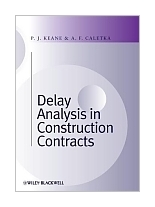|
||
• wydawnictwa polskie
• Zamów informacje o nowościach z wybranego tematu • kontakt
• Cookies na stronie |
DELAY ANALYSIS IN CONSTRUCTION CONTRACTSKEANE P.J. CALETKA A.F.wydawnictwo: WILEY-BLACKWELL , rok wydania 2008, wydanie Icena netto: The most significant unanticipated costs on many construction projects are the financial impacts associated with delay and disruption to the works. Assessing these, and establishing a causal link from each delay event to its effect, contractual liability and the damages experienced as a direct result of each event, can be difficult and complex. This book is a practical guide to the process of delay analysis and includes an in-depth review of the primary methods of delay analysis, together with the assumptions that underlie the precise calculations required in any quantitative delay analysis. The techniques discussed can be used on projects of any size, under all forms of construction contract, both domestic and international. The authors discuss not only delay analysis techniques, but also their appropriateness under given circumstances, demonstrating how combined approaches may be applied where necessary. They also consider problematic issues including ‘who owns the float’, concurrent delay, early completion programmes, and disruption. The book, which is well illustrated, features practical worked examples and case studies demonstrating the techniques commonly used by experienced practitioners. This is an invaluable resource to contractors, architects, engineers, surveyors, programmers and delay analysts, and will also be of interest to clients’ professional advisors managing extension of time or delay claims, as well as construction lawyers who require a better understanding of the underlying assumptions on which many quantitative delay analyses are based. Dr. P. John Keane, chairman of Keane Associates, has thirty years' experience in the construction industry and is also an experienced arbitrator. Anthony F. Caletka, PE, CFCC, CCM, is a managing director at PricewaterhouseCoopers and has twenty four years' experience in project and construction management, particularly on large civil engineering projects. He has had extensive experience of construction arbitration, litigation and dispute review boards and was a member of the SCL Delay and Disruption Protocol drafting committee. Table of Contents Preface. 1 Introduction. 1.1 General. 1.1.1 Purpose of ‘delay analysis in construction’. 1.1.2 Guidance. 1.1.3 Construction planning and programming. 1.2 Construction delays. 1.2.1 Identifying delays. 1.2.2 Analysing construction delays. 1.2.3 Delay claim life-cycle. 1.3 Burning issues in delay analysis. 1.4 Presentation and case study. 2 Construction Programmes. 2.1 Introduction. 2.1.1 Planning, Programming and Project Controls. 2.1.2 Elements of a successful project. 2.2 Planning and Programming. 2.2.1 Project Planning. 2.2.2 Work Breakdown Structure. 2.3 CPM Programming Techniques; the Fundamentals. 2.3.1 Activity Durations. 2.3.2 Activity Relationships. 2.3.3 Event Date Calculations. 2.3.4 Forward Pass. 2.3.5 Backward Pass. 2.3.6 Total Float. 2.3.7 Constraints. 2.4 Baseline Validation. 2.4.1 Joint Baseline Review. 2.4.2 Programme Approval. 2.4.3 The Project Baseline. 2.5 Other Planning Techniques. 2.5.1 PERT – Project Evaluation and Review Technique. 2.5.2 Gantt Charts (Bar Charts). 2.5.3 Line of Balance. 2.5.4 Critical Chain Method/Theory of Constraints. 2.6 Why use CPM Planning or Scheduling Techniques?. 2.6.1 Project Management. 2.6.2 As-planned programmes. 2.7 Project Controls and the Project Control Cycle. 2.7.1 Progress Monitoring. 2.7.2 Process and Analyse Information, Earned Value Method. 2.7.3 The Cost and Schedule Performance Curves. 2.7.4 Time Control. 2.7.5 Programme Updates. 2.8 Records, Records, Records…. 2.8.1 Electronic Records. 2.9 Predatory Programming Practices. 2.10 Guidance. 3 Identification of Construction Delays. 3.1 Establishing a Basis for Identifying Delay. 3.1.1 General Requirements. 3.1.2 Validation of an As-Planned Programme. 3.2 Factual Evidence and As-Built Programmes. 3.2.1 As-Built Programme Preparation. 3.2.2 Summary. 3.3 Identification of Delay Events. 3.3.1 Delay Identification. 3.3.2 Recording Delays. 3.4 Identification and Analysis of Disruption. 3.4.1. Disruption and Delay. 3.4.2 Calculating Disruption. 3.4.3 Establishing Cause. 3.4.4 Total Cost Claims/Global Claims. 3.4.5 Measured Mile. 3.4.6 Graphical Presentation. 3.4.7 Summary. 4 Analysis of Construction Delays. 4.1 Introduction to Delay Analysis Techniques. 4.1.1 The use of CPM techniques. 4.1.2 Project Planning Software. 4.1.3 Identifying Delays – Cause or Effect?. 4.2 Explanation of the Available Techniques. 4.2.1 Additive Methods of Delay Analysis. 4.2.2 Impacted As-Planned. 4.2.3 Time Impact Analysis. 4.2.4 Collapsed As-Built. 4.2.5 As-Built Based Methods of Analysis. 4.2.6 Total Time Assessments. 4.2.7 As-Planned versus As-Built Windows Analysis. 4.2.8 Contemporaneous Windows Analysis. 4.2.9 Month-to-Month Update Analysis. 4.3 Selection Criteria and Guidance. 4.3.1 The SCL Delay and Disruption Protocol. 4.3.2 The Core Statements of Principle. 4.3.3 Recommended Practice No. 29R-03 ‘Forensic Schedule Analysis’. 4.3.4 Which technique to use under given circumstances. 4.4 Summary. 5 Problematic Issues. 5.1 Introduction. 5.2 Float and Delay Claims. 5.2.1 General Definitions -- What is ‘Float’?. 5.2.2 How Float is used. 5.2.3 Float Loss and the Impact. 5.2.4 Measurement of Float Loss. 5.2.5 Who Owns the Float?. 5.3 Concurrency. 5.3.1 Definitions. 5.3.2 Delay Analysis and Concurrency. 5.3.3 SCL Delay and Disruption Protocol. 5.3.4 Delay Scenarios. 5.3.5 Common Questions. 5.3.6 Experience and Commonsense. 5.3.7 The Concept of Pacing. 5.4 Programme Approvals and Onerous Specifications. 5.4.1 Programme Requirements, Format and Compliance. 5.4.2 Approval or Acceptance of Construction Programme. 5.5 Acceleration and Mitigation. 5.5.1 Mitigation. 5.5.2 Acceleration. 5.5.3 Contractors’ right to early completion. 6 Effective Presentation of Delay Analysis. 6.1 Introduction. 6.2 Case Study – Airport Terminal Expansion. 6.2.1 Initial analysis by party appointed planning experts. 6.2.2 Using Time Impact Analysis for Prolongation. 6.2.3 Tribunal Planning Expert’s Contemporaneous Approach. 6.2.4 Runway Extension - Are delays to the Runway Extension relevant?. 6.2.5 Terminal Building – Are delays to the Terminal Building relevant?. 6.3 Float Mapping - Approach and Methodology. 6.3.1 Extracting Float Values. 6.3.2 Create Float Map. 6.3.3 Identify Driving Activities. 6.3.4 As-Built Critical Path. 6.4 Demonstrating Acceleration. 6.5 Presentation Skills – Demonstrative Evidence. 6.5.1 Summary. Index 288 pages, Hardcover Księgarnia nie działa. Nie odpowiadamy na pytania i nie realizujemy zamówien. Do odwolania !. |


